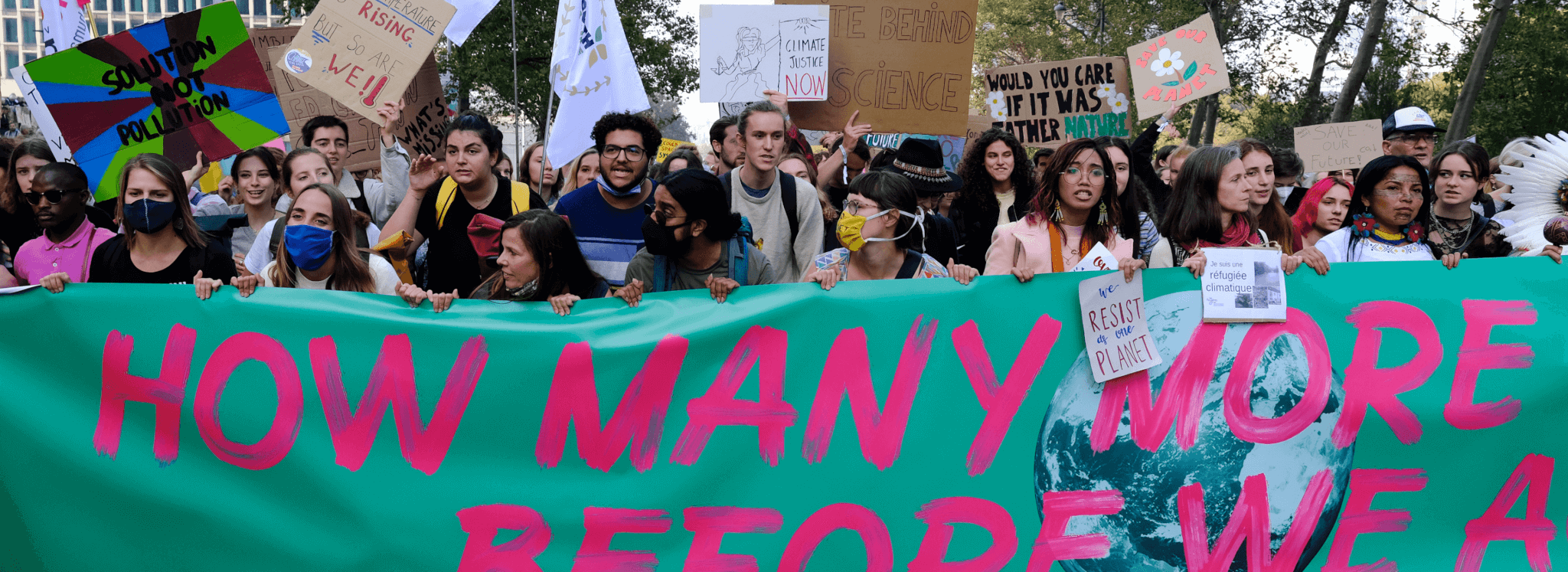
The Intergovernmental Panel on Climate Change (IPCC) has released the latest installment in its Sixth Assessment Report. The Working Group III (WGIII) report focuses on climate change mitigation and the policy, technological, and social levers we must urgently mobilize to keep the world below 1.5C of warming by the end of the century. It adds to the body of science the IPCC has released in this cycle – the latest science behind climate change (Working Group I report) released in August 2021 and the impacts of climate change, including limits of natural ecosystems and society to adapt to disastrous climate change impacts, (Working Group II report) released in February this year. The WGIII report lays out very starkly that if we miss the window to act on climate change over the next few years, we will no longer be able to stabilize the climate at under 1.5C of warming. As the WGI and WGII Reports bleakly highlighted, climate impacts are already affecting people on every continent of the world at just 1.1C of warming, so every fraction of a degree matters.
One of the main messages of the latest IPCC Report is that we need to urgently use all our tools to tackle the climate crisis, not just a few, and we must do so at scale. If we do, we can together shift onto a better path for the climate this decade before it is too late.
One of the main messages of the latest IPCC Report is that we need to urgently use all our tools to tackle the climate crisis, not just a few, and we must do so at scale.
To meet the Paris Agreement goals, governments and businesses need to halve greenhouse gas emissions by 2030. The IPCC report shows that sustained emissions reductions are possible with supportive policies. At least 18 countries have sustained GHG emissions reductions in annual CO2 and GHG emissions for well over a decade. Many achieved these emissions reductions alongside sustained economic growth. This trend, both for consumption and production-based emissions, needs to be amplified and expanded to many more countries. A range of strategies enacted through policies can limit warming, including:
Electrify the global energy system with carbon-free energy and phase-out fossil fuel infrastructure.
The cost of renewables has fallen so precipitously that they have become the default economic choice for new power generation capacity. Scaling all forms of zero-carbon power generation can also benefit other sectors. Some of these technologies already exist, and some, like green hydrogen, need to be scaled rapidly.
Electrify all modes of transportation to slash emissions.
Powered by abundant renewable energy, electric transportation can eliminate over 90% of transport-related climate pollution and nearly all oil demand from road transport. It is an important part of a broader package, including a focus on compact urban design, public transport, and non-motorized transport.
Slash short-term super pollutants by 34% by 2030 instead of 2050.
Eight years ago, the IPCC targeted reducing methane by 34% by 2050. The latest report significantly moves up that deadline to 2030. The immediate reduction in methane, hydrofluorocarbons (F-gases), black carbon, and ground-level ozone can dramatically slow the rate of warming in the near term and offers a chance to meet net-zero emissions targets by 2050.
Address the climate finance gap immediately.
Rich countries are overdue in delivering on their promise of giving $100 billion per year in climate finance to less wealthy nations to help them mitigate and adapt to climate change. Without financing options, people living in the most vulnerable nations cannot adapt and will suffer the most.
Removing excess carbon from the atmosphere is essential to restoring the climate.
The IPCC report makes clear there are no pathways to 1.5C that don’t include carbon removal. Natural sinks as well as technologies that mimic nature will be needed and scaled to meet the challenge of removing legacy CO2 emissions. Natural sinks alone cannot solve the problem. For more on the IPCC’s findings on carbon removal, read here.
Embed sustainable development in transitions.
Inequitable decisions lead to resistance, and we cannot expect to scale low carbon transition solutions without embedding principles of equity and a just transition into decisions. If done well, bold climate action can boost jobs and income, lead to significant health benefits and more inclusive, sustained growth. But we also need to understand and manage any trade-offs.
Apply holistic approaches to reduce carbon in buildings.
Smarter building design and construction choices made today can reduce emissions for decades to come. The IPCC report offers a range of interventions to decarbonize the built environment across the building lifecycle, including retrofitting existing building stock, repurposing existing buildings, and using low-emission construction materials.
Build a circular economy.
We can strengthen policies and innovation around using materials more efficiently to reduce waste and emissions. This includes more materials recycling, especially in the industrial sector.
Gain large-scale emissions reductions from sustainable shifts in agriculture, forestry, and other land use.
The IPCC report underscores the untapped mitigation potential in this space. Measures such as sustainable forest management, reforestation, soil carbon management, sustainable crop and livestock management, and healthier diets can provide as much as 20%-30% of the emissions reductions needed to meet climate goals.
A rapid but orderly low-carbon transition can reduce risk globally. Government decisions about when and how to implement a national clean energy transition matter. It influences energy security and how nations react in times of calamity. Russia’s invasion of Ukraine has underscored the massive dangers of continuing our addiction to oil and gas. By pursuing orderly, planned transitions to reaching net-zero targets by 2050, including immediate near-term action, countries can help avoid worst-case scenarios, enhance energy and food security, and reduce geopolitical and economic risks. There is a limit to how many times society can adapt to shocks, be it financial or energy, food, or extreme climate event related.
To help nations decarbonize their economies, central banks, governments, businesses, and civil society groups need robust economic analysis to better integrate the opportunities and costs of climate action and an understanding of the risks of inaction in their climate action frameworks. An integrated framework to assess the physical and transition risks stemming from the impacts of a warming world can help show the advantages of shifting to a low-carbon economy and how to avoid costly lock-in of fossil assets. We need to identify, categorize, calculate, and balance the associated societal, economic, and financial impacts of climate action and inaction and reflect that in country budgets, and economic and investment planning.
For the first time, the IPCC report recognizes that a rapid transition to a low-carbon economy will not be a drag on the economy, with the underlying models used for the assessment having reflected some of the latest rapidly falling costs of clean energy and other solutions which have increasingly made them cost-competitive with fossil fuel based power. Once the much larger costs of inaction are considered as well, and the dynamic opportunities of new innovations through a net-zero economy, many other analyses suggest the opportunity for a significant net benefit from bold climate action instead. The new IPCC report reflects an important first step in the economic modeling frameworks catching up with reality, but there is still more to be done.
Philanthropy is vital to increasing the pace and scale of climate action
The IPCC’s recommendations for climate change mitigation represent a huge step-change in how the community needs to work together to raise and deploy the resources and supportive policies and technologies needed to tackle the climate crisis. This is where philanthropy has been and must continue to play a critical role in catalyzing action at the scale and speed the world needs. Below are areas where philanthropy can substantially help to avoid a code red future.
- Cross-sectoral approach to integration of solutions — Achieving full mitigation means all stages—from production to consumption to transportation and disposal—have to be considered in addressing emissions, utilizing both supply and demand side measures in various sectors, as noted in the report. An example being food systems where philanthropy can support multi-disciplinary approaches to how one integrates innovative technology, energy use, biodiversity, human and ecosystem health and livelihood protection while solving for tradeoffs and synergies to achieve both climate and societal goals.
- Equitable and a just transition — The world can only win on climate if we ensure the major system-wide transformations needed actually work for people – as individuals, communities, and economies. Philanthropy is well positioned to support a diversified set of solutions that reflect social and economic justice by supporting people-led movements and ensuring the voices of the most vulnerable and underrepresented groups are heard.
- Transparency and accountability are essential building blocks for effective climate action, increasing ambition, and building international credibility. Philanthropic-led initiatives can drive accountability by helping stakeholders clearly understand where action is on track and where more effort is needed.
- International multi-stakeholder cooperation — Philanthropy is adept at bringing together relevant actors from governments, NGOs, businesses, people-led movements, and other civil society groups to foster radical collaborations and elevate new approaches that deliver results. The recent COP26 in Glasgow showcased a number of breakthroughs and new pledges, and we now have to deliver on them and hold ourselves accountable.
The best pathway to tackle the climate crisis is to accelerate an orderly transition to zero emissions, deploying all the levers we have available. We have the tools and solutions to cut emissions in half by 2030 and achieve net-zero emissions by mid-century. The IPCC report is clear: the primary barriers we face are not technical or economic, they are political. But with financing and better collaboration across governments, communities, businesses and philanthropy, we can keep the 1.5C goal in our sights.



